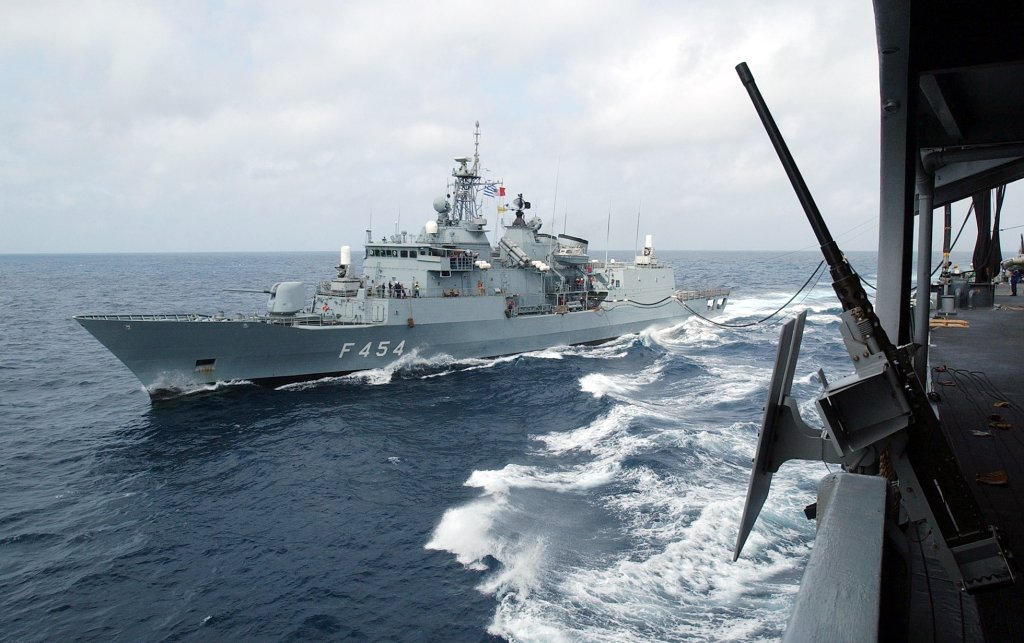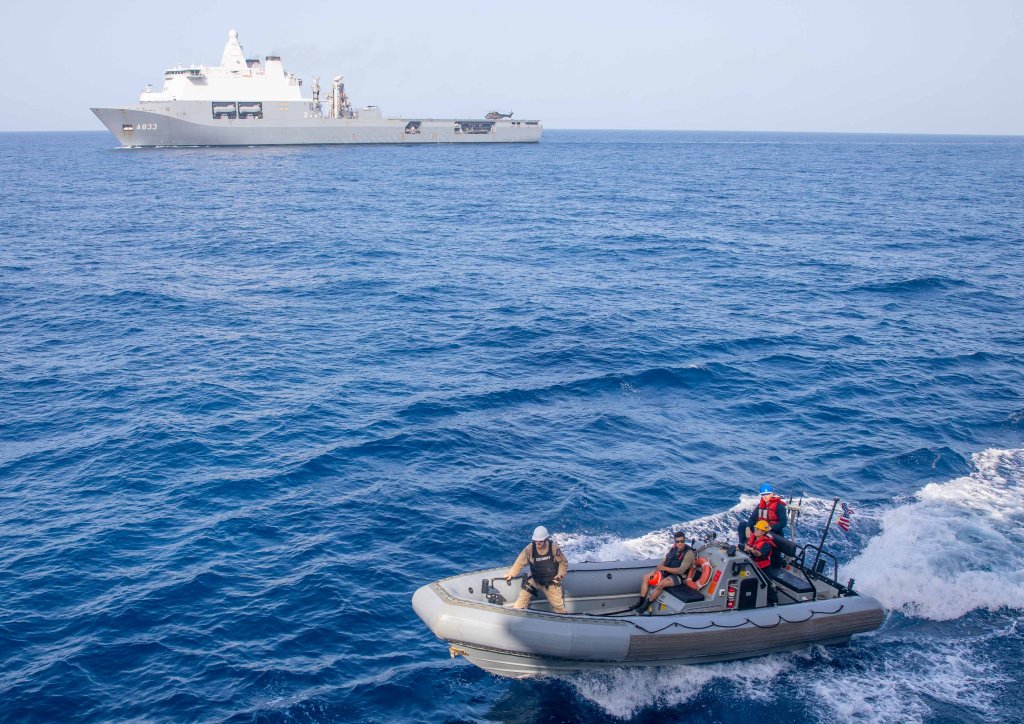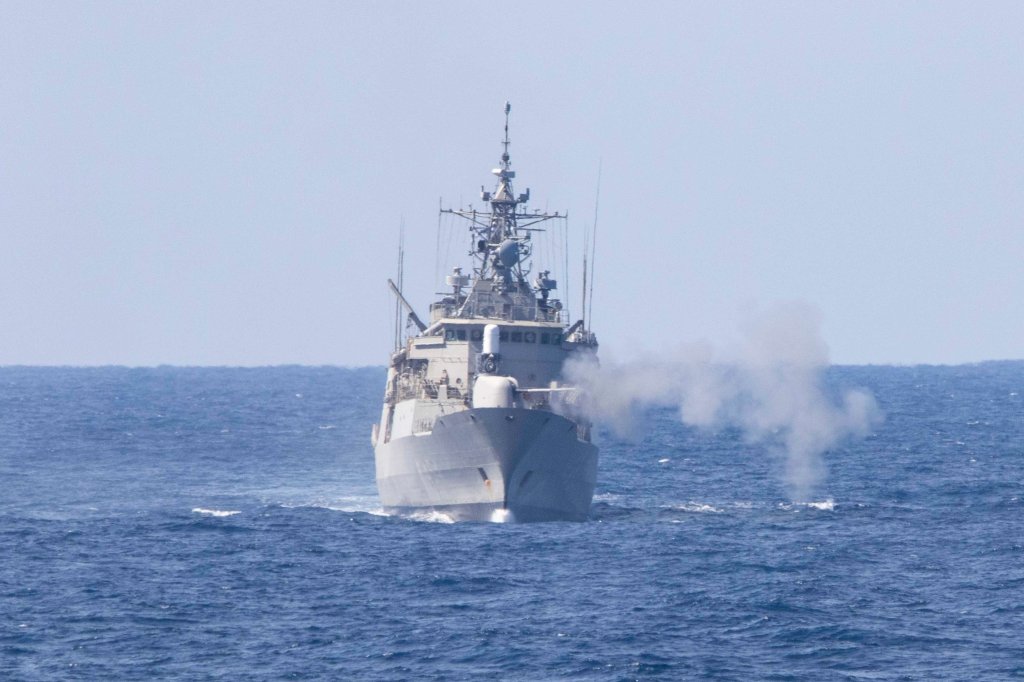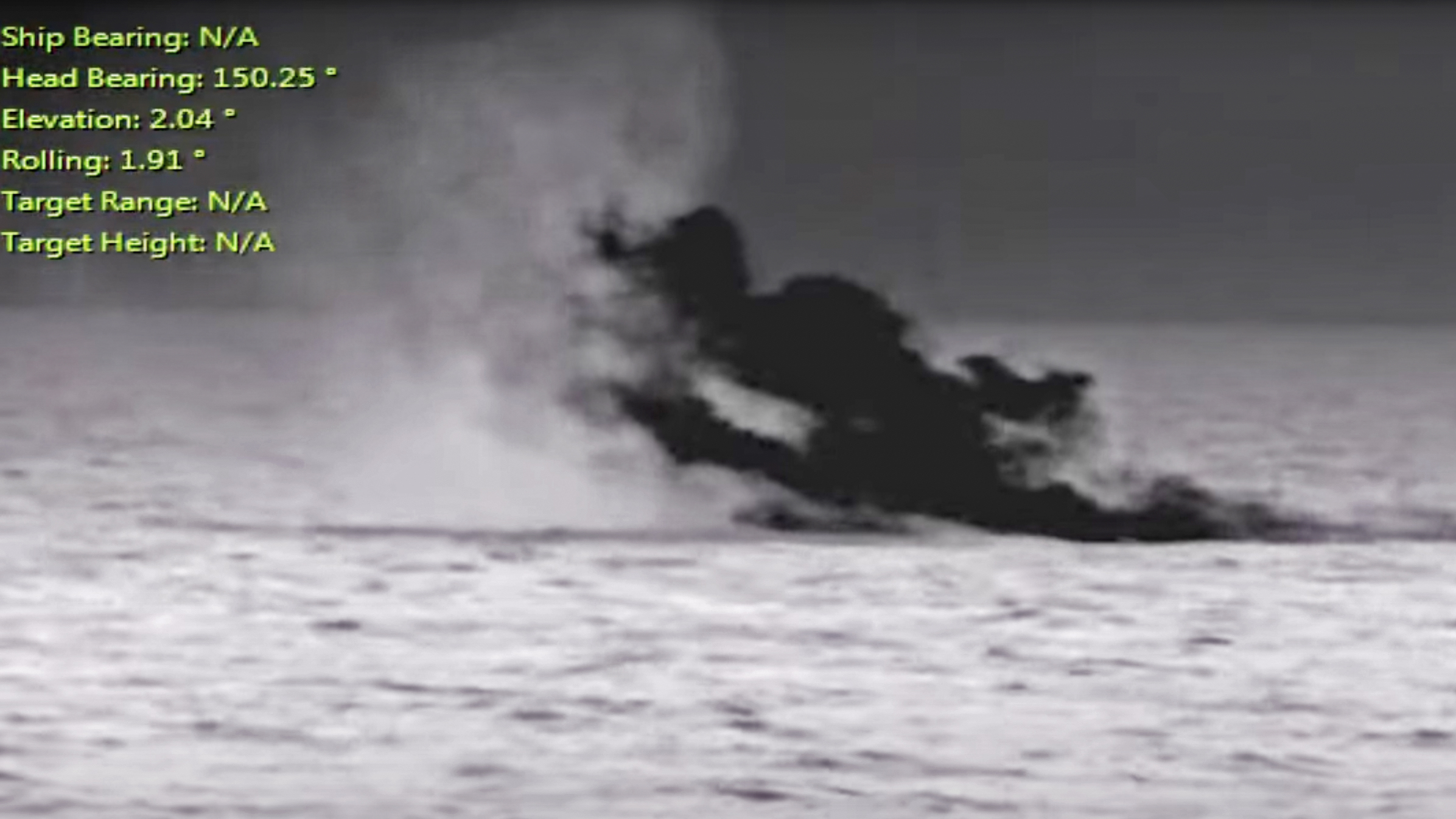A video has emerged showing a Greek warship knocking out a Houthi drone. It is one of the latest such incidents in an ongoing campaign that has been waged by the Iranian-backed rebel group since last November, in the wake of the outbreak of the Israel-Hamas war. In this encounter, the Hellenic Navy frigate apparently used its 127mm main gun, reinforcing the utility of these kinds of weapons against drones. There have also been reports that the same warship may have successfully used a newly installed electronic warfare counter-drone system to bring down another drone in the same incident.

Footage of the encounter was published by the Royal Netherlands Navy, which is, alongside the Hellenic Navy and others, taking part in the European Union’s Operation Aspides, the mission to escort and protect commercial shipping in the region.
The incident took place while the Hellenic Navy’s Hydra class (MEKO 200) frigate Psara and the Royal Netherlands Navy’s multirole amphibious support ship Karel Doorman were escorting a freighter together through the Gulf of Aden.

According to the Dutch Ministry of Defense, the frigate Psara shot down two Houthi drones off the Somali coast on the night of July 7. One of those drones is seen being destroyed by gunfire in the accompanying video. Prior to its demise, the drone, which appears to be a Samad variant, climbs and descends over the waves in what seems to be a tactic to make it harder to intercept.
The Dutch account states that the Karel Doorman warned the Greek warship of the approaching threat and was “ready to provide medical support if necessary.” However, there were no injuries reported during the attack and no material damage. “The freighter was able to continue its journey safely,” the Dutch Ministry of Defense says.

The description of the incident on the official X social media account of Operation Aspides describes a total of four drones threatening shipping, two of which were brought down by the Greek frigate, while the others changed course, presumably departing the area.
The Dutch Ministry of Defense’s account describes the Psara using “various weapon systems and the cannon” to engage the Houthi drones, although no further details are provided. The video, however, shows a gun engagement — reportedly using the 127mm Mk 45 main gun — although another system may have been responsible for downing the other drone.
Additional defensive armament on the Hydra class frigate comprises a vertical launch system for 16 RIM-162 Evolved Sea Sparrow Missiles (ESSM) and a pair of Mk 15 Phalanx 20mm close-in weapon systems (CIWS). The warship can also embark an S-70B Sea Hawk and helicopters have previously been used in this campaign to intercept and shoot down drones.
Most intriguingly, unnamed sources told the Greek newspaper Kathimerini that the incident saw the employment of a new non-kinetic anti-drone system, which is claimed to have downed one of the UAVs.
The report suggests that the locally developed Centaur anti-drone system, a product of Hellenic Aerospace Industry (HAI), detected four aerial targets at a range of more than 15 nautical miles, bringing down the first of the drones before it came within the range of the frigate’s gun, by “interfering with its communications and GPS.” The second drone was then hit by the frigate’s gun.
Using non-kinetic methods to tackle drone threats is something that has been attracting considerable interest for a while, and which has been spurred by developments in the Red Sea as well as in Ukraine. Different examples include directed-energy weapons like lasers or high-power microwaves, as well as electronic warfare jammers. The latter technology is used by the Centaur system, but otherwise, few details are available.
“This attack shows that it is still very unsafe for shipping in this region. With the deployment of units from E.U. countries, we are able to protect shipping and maintain free passage,” said Cdr. George Pastoor, a member of the Royal Netherlands Navy onboard the Psara at the time of the engagement.
A spokesperson for Operation Aspides confirmed to TWZ at the end of last month that the mission comprised the Karel Doorman as well as three frigates: one French, one Greek (the Psara), and one Italian. We have also reached out to Operation Aspides for more details on the weapons used by the Psara.
“Aspides continues to operate with the same defensive mandate: to protect vessels against the Houthis’ attacks in international waters, to accompany vulnerable ones, and to foster maritime security in the Red Sea and Gulf area,” the same spokesperson said.
“The frequency and kind of threats make Aspides a highly kinetic operation. Recent events show that Houthis’ attacks are becoming more complex and potentially more harmful. We are increasing our monitoring and make all efforts to match and neutralize the Houthis’ attacks. Aspides will spare no effort to protect maritime shipping and restore free and safe passage for all,” they added.
As we have seen on multiple occasions, the Houthis are using a combination of aerial drones as well as uncrewed surface vessels (USVs) together with ballistic missiles — including dedicated anti-ship ballistic missiles (ASBMs) — and cruise missiles to hold commercial vessels and warships in the region at risk. A relatively new kind of threat, ASBMs have seen their first confirmed combat use in the current Houthi campaign.
As well as strikes, aerial drones are used by the Houthis for reconnaissance and targeting, but it is unclear what missions the drones were flying when shot down by the Psara.
In response to the Houthi drone threat specifically, the Royal Netherlands Navy says it has been “conducting exercises and preparing new systems for some time now,” but did not provide more details.
As for the Karel Doorman, this also has some anti-drone air defense systems, albeit only effective in the close-range domain, with two Goalkeeper 30mm CIWS, two 30mm Marlin WS rapid-fire guns, plus several machine guns. It can also embark helicopters — up to six in total.
This is not the first time that a Greek warship deployed on Operation Aspides has successfully engaged Houthi drones. In March this year, for example, another MEKO 200 frigate, the Hydra, opened fire on two drones launched by the militants that were “posing an imminent threat to the freedom of navigation.”
In April, the Hydra responded to another two drones that were headed toward a commercial ship in the Gulf of Aden, the Greek Ministry of Defense announced. Greek officials told Reuters that one of the drones was destroyed while the second “moved away.”
Interestingly, however, despite these apparent successes, there were also reports of technological problems encountered by the Hydra while in the region. The Greek iEidiseis news website reported that on May 19, while in the Gulf of Aden, a Houthi drone exploded less than 500 feet from the warship, having apparently evaded its defense systems.
The Greek Ministry of Defense declined to comment on those reports.
The weapons used in the earlier incidents involving the Hydra were not announced but, in addition to extensive use of surface-to-air missiles, there have been previous encounters in which warships have used their main guns to tackle aerial drones.
For example, in March we detailed how the Italian Navy Andrea Doria class destroyer Caio Duilio shot down a Houthi drone at a relatively close range of under four miles. It appears that a deliberate decision was taken to avoid using expensive surface-to-air missiles and instead rely on the warship’s gun armament to bring down drones. It reportedly fired seven or eight rounds from one or more of its three 76mm Super-Rapid guns.
The Italian Ministry of Defense said that the destroyer was acting in self-defense when it downed the drone, which was flying toward the warship.
Interestingly, the Super-Rapid guns on the Italian warship can fire DART projectiles that employ radio-command guidance for accuracy, optimizing them for the anti-missile and anti-drone defense role. The 127mm Mk 45 gun on the Hydra class frigate is not known to have a similar option, instead firing different kinds of high-explosive projectiles.

As we have pointed out in the past, using guns to engage drones is a notably cheaper way of dealing with these kinds of threats. The medium-range Aster 30 missile that has been used by the French and U.K. navies to engage Houthi missile and drone threats reportedly cost around $2 million for each round.
The disparity between the cost of advanced naval surface-to-air missiles like these and the Houthi missiles and drones that they have been targeting is something we have explored in the past.
There is also the issue of magazine depth, with warships potentially running low on surface-to-air missiles, depending on the volume of threats they have been engaging. In February, we saw the U.K. Royal Navy destroyer HMS Diamond being reloaded with missiles in Gibraltar after shooting down nine drones off Yemen over the span of a few months.
On the other hand, using guns to engage drones is a far riskier option in certain situations. While a drone may not be able to sink a larger ship, it can cause considerable damage and put the vessel out of action for a very long time. A decision to use guns instead of missiles will therefore have to be made based on the particular threat and available weaponry.
Last weekend, HMS Diamond returned to its home port at Portsmouth in England, with ‘kill’ markings on the bridge wings indicating the destruction of nine drones and one ballistic missile via Sea Viper missiles and guns during its time around the Red Sea. The deployment included shooting down seven drones aimed at merchant vessels in one day — the most aerial threats neutralized by a Royal Navy warship in modern times, according to the service.
HMS Diamond was deployed separately to Operation Aspides, as was the Danish frigate Iver Huitfeldt, which was forced to wind up its Red Sea tasking early after air defense malfunctions that you can read more about here. Originally deployed to the Red Sea in January, the problems that plagued the Danish warship —especially the ESSM launcher — led to the sacking of the Danish chief of defense, Gen. Flemming Lentfer. Now it has emerged that the same issues affecting the Iver Huitfeldt have still not been addressed, preventing it from serving as the flagship of NATO’s Standing Maritime Group One this summer, as had been planned.
“We have had to change the Danish contribution to NATO’s SNMG1, the challenges experienced by the crew of Iver Huitfeldt during the mission in the Red Sea have still not been resolved — therefore, we are following the Defense Command’s recommendation not to deploy the frigate for seagoing service,” Danish Minister of Defense Troels Lund Poulsen confirmed on June 27.
As more experience is gained in the campaign around the Red Sea, tactics will adapt, and it may well be the case that in certain situations a gun engagement is now being prioritized to save more expensive missiles.
With this in mind, it is understandable, too, that navies are increasingly looking at non-kinetic counter-drone solutions like the HAI Centaur, although it remains to be confirmed if this system was indeed responsible for bringing down one of the drones. At the same time, certain non-kinetic options have some of the same drawbacks as guns, with directed-energy weapons, in particular, requiring the threat to be relatively close before it can be successfully engaged as well as limitations as regards how fast they can engage multiple targets.
After many months of their anti-shipping campaign, the reality of the Houthis being able to sink vessels was hammered home in June when the militants successfully targeted the Liberian bulk carrier Tutor using a USV, while it was transiting the Red Sea.
As long as the Houthis continue to target commercial shipping, there will be no let up for the warships assigned to protect vessels in these waters and we will continue to see a range of different weapons employed against the militants’ drones and missiles.
Contact the author: thomas@thewarzone.com
